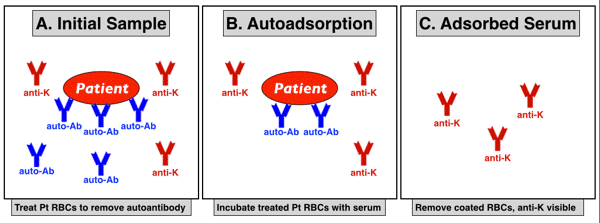Glossary
Autoadsorption
Read the “Adsorption” definition first, if you have not already done so.
Autoadsorption is an advanced blood banking technique that is most often useful in the workup of warm autoantibodies. Usually, warm autoantibodies react very well against everyone’s RBCs, making antibody identification difficult because all of the cells on an antibody detection test or panel are incompatible with the patient’s serum. As a result, identifying an alloantibody can be very difficult, since the autoantibody “masks” the visibility of the alloantibody.
In the example below, imagine a patient with a warm autoantibody who has also developed an alloantibody, anti-K. Let’s walk through the steps to perform an autoadsorption:
-
- The initial sample (panel A) has autoantibody coating the patient’s RBCs as well as in the plasma, and anti-K floating around in the plasma.
- To perform an autoadsorption, we first separate the plasma from the RBCs, with the intent to re-incubate them together later. We generally need to remove the autoantibody from the patient’s RBCs before we do that, so the patient’s RBCs are first treated to remove the autoantibody (using chemical or temperature methods), and then the autologous RBCs are re-incubated with the plasma (panel B). Think about it: Since the patient has formed an alloantibody to the K antigen, the patient, by definition, is K-negative. As a result, the autoantibody should bind to the patient’s own RBCs, while the anti-K should NOT bind to those RBCs.
- When the plasma is separated from the RBCs after centrifugation, the anti-K present in the “adsorbed serum/plasma” can then be identified by testing using screening cells and/or a full antibody panel (panel C).

A couple of quick things about this to note: First, autoadsorptions can only be done if the RBCs are ONLY the patient’s RBCs! In other words, if the patient has been transfused “recently” (usually interpreted as “in the past 3 months“), autoadsorption is not an option (instead, alloadsorption is necessary). Second, sometimes, multiple autoadsorptions are necessary to remove strong autoantibodies. This process can add significant time to the workup, and can be technically challenging, as well.
Back to Glossary List

